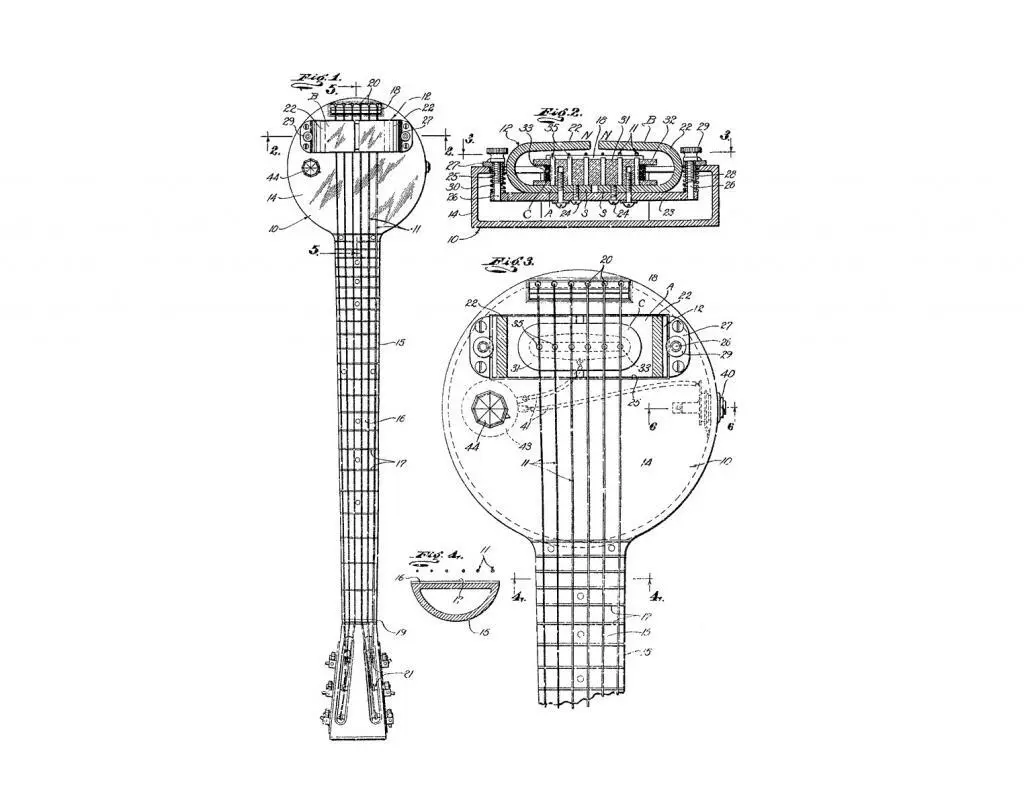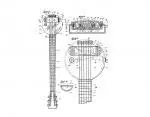Electric Frying Pan most likely refers to Rickenbacker Electro A-22, more colloquially known as the “frying pan” due to its unique shape. The frying pan is considered the first full-fledged electric guitar ever produced, and it played a significant role in the development of modern music.

What is Electric Frying Pan: Table of Contents
The early 1930s was a period of rapid technological change, which echoed profoundly in the realm of music production. Musicians and innovators were grappling with the possibilities presented by electric amplification, trying to overcome the limitations of acoustic instruments and project their creative voices further than ever before. At this time, the music industry was looking for ways to make instruments louder, to cut through the noise of big bands and reach the back rows of increasingly large venues.
The concept of electrically amplified instruments was not entirely new. Since the late 1920s, various experiments had been conducted with rudimentary pickups and amplifiers, primarily on stringed instruments like violins and guitars. Yet, it was only during the early 1930s that we saw the first significant strides being made in this direction. The goal was clear – harnessing electricity to revolutionize the world of music.
Introduction to the Unique Electric Frying Pan
Amid this exciting atmosphere of innovation, a distinctive instrument emerged that would mark a significant milestone in the evolution of electric guitars: the Electric Frying Pan. At first glance, one could easily mistake it for a kitchen utensil rather than a musical instrument. Its body, round and wide like a frying pan, was linked to a long handle – the neck of the instrument.
The Electric Frying Pan was no novelty or gimmick. It was a serious answer to the call for electrically amplified stringed instruments. Despite its peculiar name, this instrument brought together ingenious design, innovative technology, and the vision of three remarkable individuals: Paul Barth, George Beauchamp, and Adolph Rickenbacker.
Design and Inception of the Electric Frying Pan
The conception of the Electric Frying Pan came about as a triumvirate of minds – Paul Barth, George Beauchamp, and Adolph Rickenbacker – brought together their respective expertise to create this groundbreaking instrument.
Paul Barth, a talented engineer with a penchant for innovation, contributed significantly to the technical design of the instrument. His keen understanding of acoustics and material properties helped shape the instrument’s unique physical attributes, ensuring it could handle the new amplification technology without losing its tonal integrity.
George Beauchamp, a professional musician, understood the necessities and challenges musicians faced during performances. His inputs were vital in making the Electric Frying Pan a practical and playable instrument that musicians would want to use. Beauchamp was also a major force behind the concept and design of the horseshoe pickup.
Adolph Rickenbacker, an established businessman, provided the financial backing and manufacturing capabilities needed to turn the design into reality. As a business strategist, his role was indispensable in bringing the Electric Frying Pan to market, ensuring it found its place in the evolving music scene.
It is important to emphasize that the Electric Frying Pan wasn’t the product of a single genius, but rather the result of a collaborative effort. Each of these individuals played a crucial role, and their collective vision and expertise were vital in creating this landmark instrument.
Detailed Explanation of the Unique Design and the Rationale Behind It
The Electric Frying Pan stands out for its distinctive form. Its circular, pan-like body, paired with an elongated handle – the neck – creates a visual impression akin to a regular frying pan. This shape, while unusual, was not chosen merely for aesthetic reasons. The round body provided an excellent surface for the large horseshoe pickup, while the long neck allowed for a good range of notes and easy playability.
The choice of materials was pivotal in the instrument’s success. Predominantly made from aluminum, the Electric Frying Pan was lightweight, making it comfortable for musicians who played for extended periods. Additionally, aluminum’s resistance to feedback – unwanted noise or distortion that can occur with amplified instruments – made it an excellent choice for an instrument pushing the boundaries of amplification. This considered choice of materials reflected an understanding not just of engineering, but of the practical needs of musicians – further evidence of the thoughtful design that went into the Electric Frying Pan.
The Horseshoe Magnetic Pickup
In the world of electric instruments, the pickup plays a pivotal role. This electromagnetic device is designed to convert the vibration of the strings into an electrical signal that can be amplified and then translated back into sound through a speaker system. Without a pickup, an electric instrument cannot fulfill its basic function.
The Electric Frying Pan, true to its innovative spirit, showcased a unique ‘horseshoe’ magnetic pickup. This pickup, nearly as large as the body of the instrument itself, was designed in a horseshoe shape, with two poles of a magnet surrounding the guitar strings. When the strings vibrate, they disturb the magnetic field between the two poles, creating an electrical signal that is sent to the amplifier. The horseshoe pickup’s size and its strategic placement right under the strings were designed to capture as much of this signal as possible, leading to a stronger, clearer sound output.
The horseshoe pickup significantly influenced the sound quality of the Electric Frying Pan. Its large size and horseshoe shape enabled it to capture more of the strings’ vibrations, which translated into a richer, fuller sound with a broad frequency range. Moreover, the pickup’s ability to efficiently convert these vibrations into an electrical signal meant that the instrument could produce high volumes without losing the clarity and character of the sound.
The technical advantages of the horseshoe pickup design are manifold. Its larger size allowed it to capture a greater range of frequencies, contributing to a warmer, more balanced tone. The direct placement under the strings ensured maximum signal capture, leading to louder, clearer sound amplification. Furthermore, the magnetic field created by the horseshoe design reduced signal interference, which minimized noise and distortion, thereby enhancing sound quality. This unique pickup design, incorporated into the Electric Frying Pan, marked a significant advancement in the development of electric guitars and continues to influence electric guitar design to this day.
The Electric Frying Pan as a Hawaiian Lap Steel
The 1930s was a period of fascination with the unique sounds and melodies of Hawaiian music, particularly the Hawaiian lap steel guitar. This instrument, played by laying it flat on the lap and sliding a metal bar or “steel” along the strings to alter the pitch, had a distinctive tone that was becoming popular across the globe. The demand for louder, electrified versions of these instruments was beginning to grow as the sounds of the Hawaiian lap steel spread far beyond its island home.
The technique for playing the Hawaiian lap steel, and consequently the Electric Frying Pan, involves positioning the instrument on the player’s lap, using the left hand to slide a metal bar across the strings while the right hand plucks the strings. This creates a unique, smooth, sliding tone, quite different from the sound of a conventionally played guitar. The lack of frets allows for continuous variation in pitch, and the technique offers a distinctive sound often described as “sweet” or “weeping.
The Electric Frying Pan’s unique design proved quite suitable for use as a Hawaiian lap steel guitar. The round, flat body allowed for comfortable positioning on the player’s lap, and the extended neck offered a wide range of notes for the sliding technique.
Furthermore, the large horseshoe magnetic pickup played a crucial role. Its size and location allowed it to capture the full range of tonal nuances created by the sliding technique. The electrical amplification, a first for lap steel guitars, enabled the instrument to maintain the characteristic tone of the Hawaiian lap steel while projecting it louder and clearer, even when played alongside full orchestras or big bands.
In essence, the Electric Frying Pan blended the traditional elements of the Hawaiian lap steel guitar with innovative design and technology, creating a unique instrument that could cater to the demand for louder, electrified performances while preserving the instrument’s characteristic sound.
Influence and Legacy of the Electric Frying Pan
The Electric Frying Pan left an indelible mark on the Rickenbacker brand. Beyond the instrument itself, the pioneering design principles, primarily the horseshoe pickup, found their way into other Rickenbacker products, most notably their bass guitars. The horseshoe pickup became a signature feature of the Rickenbacker basses, renowned for their rich, clear, and warm tone. The Electric Frying Pan, thus, not only enriched the brand’s offerings but also shaped its identity, positioning Rickenbacker as a forward-thinking and innovative force in the music industry.
The influence of the Electric Frying Pan extends far beyond Rickenbacker’s catalog. As the first commercially successful electric lap steel guitar, it showcased the potential of electric amplification in a practical and playable format. The innovation it brought to the scene, especially the horseshoe pickup, impacted electric instrument design on a larger scale. It informed the development of subsequent electric guitars, paving the way for instruments capable of greater volumes without sacrificing sound quality.
Moreover, it contributed significantly to the shift in music styles and genres, enabling artists to experiment with new sounds and compositions. The Electric Frying Pan played a role in the emergence of various music genres, like rock and roll, where the amplified guitar became a defining element.
Looking back, the Electric Frying Pan was more than just an instrument; it was a bold statement of intent, a vision of what the future of music could be. At a time when the idea of an electric guitar was still in its infancy, this odd-looking creation proved that electric amplification wasn’t just feasible; it was transformative.
The Electric Frying Pan changed perceptions and opened the door for widespread acceptance of electric guitars. It demonstrated the practicality and benefits of electrified instruments, forever altering the course of music history. Its legacy is not just in the guitars that bear its design elements but also in the music that those instruments have helped create. The Electric Frying Pan is a testament to the role of innovation in shaping the world of music, reminding us that sometimes, a frying pan can indeed be much more than just a frying pan.

